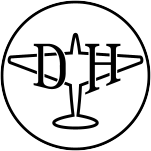
de Havilland
Notes
Construction numbers
Sometimes referred to as build number or msn, the c/n is a (usually sequential) number allotted to each aircraft built by an aircraft manufacturer. DeHavilland started at number 1 but once a number of models had been developed each model was given a separate sequence.
In the case of the Airspeed Oxford built by DeH the sequence overlapped with that of the Tiger Moth.
Some confusion is created as a result of overseas manufacturers, who produced the Moth and Tiger Moth under licence, using their own c/ns in the same series.
The Tiger Moths built by De Havilland in the UK, Australia and New Zealand have a metal plate on the cockpit panel identifying the construction number and manufacturer. Aircraft built by Morris Motors have a brass plate riveted to the top face of the bottom longeron starboard side near the pilot's feet quoting 'MCO DHxxxx DRG NO U2925'. If the magic number 81923 is added to the 'xxxx' number you arrive at the c/n!
B class markings
Reference will be seen to serials of the format E-xx (i.e. the prototype Puss Moth c/n 396 was registered E-1). These are Class B markings allocated to manufacturers for test or experimental purposes. The prefix for De Havilland was originally E- followed by one or two digits.
During the second world war this was amended to E followed by a zero and three digits (ie E0234 was the Mosquito prototype). Subsequently manufacturers were given codes which consisted of G- followed by an individual number identifying the manufacturer (5 for De Havilland), a dash, and a sequential number.
Spanish Civil War Aircraft
The following codes were worn by aircraft on both sides in the Spanish Civil War
| Type | Nationalist code | Republican code | |
|---|---|---|---|
| DH60 Moth | EM | ||
| DH80 Puss Moth | |||
| DH82 Tiger Moth | EP | ||
| DH83 Fox Moth | 30 | ||
| DH84 Dragon | LD | ||
| DH85 Leopard Moth | 30 | ||
| DH87 Hornet Moth | TH | ||
| DH89A Dragon Rapide | 40 | LR | |
| DH90 Dragonfly | LY |
Portuguese Army Codes
Portuguese serials were changed many times. Originally the serials were allotted by base:
- Sintra used 1,2,3 etc which later changed to 100,101 etc
- Tancos used 10,11,12 etc which changed to 135,136,etc
In 1937 the system changed so that all Moths had serials in the 101-150 range and Dragons were in the 501-549 range. The Moth which was previously 100 became 120.
In Mozambique Tiger Moths wore 1-9 and the Hornet Moth 10
In 1952 the system changed again to 1180-1188 for the Tigers and 9201 for the Hornet but this change was probably not implemented. The Dragon became 23..
Elementary Flying Training Schools ('EFTS')
The Tiger Moth was principally used during the war by the Elementary Flying Training Schools
For details of the EFTS and other training schools click here
The DX and MC serials
A total of 420 RAF serials in the DX... series were allotted to Australian built Tiger Moths, of which 214 serials were actually applied. 94 of these aircraft went to Rhodesia and 120 to South Africa. The South African Air Force aircraft were given SAAF serials in the 2300 and 2400 range. The Rhodesian aircraft were generally painted with the code 'MC-' followed by the DeHavilland Australia production number (i.e DHA526 was DX437 but was painted MC-526).
The aircraft concerned were in the production run DHA526 through to DHA791.
This run included 50 aircraft which went to the RAAF and 2 aircraft to the Netherlands East Indies - these did not get DX serials.
The DX serials were 437-461 474-512 529-557 569-612 627-665 679-716 (214)
There was some confusion after the war when the 1945 RAF census assumed that the 'MC' codes were actually RAF serials. As as result Form 78 movement cards were created for the surviving aircraft. In addition various movement cards confuse the DX serial with the MC serial.